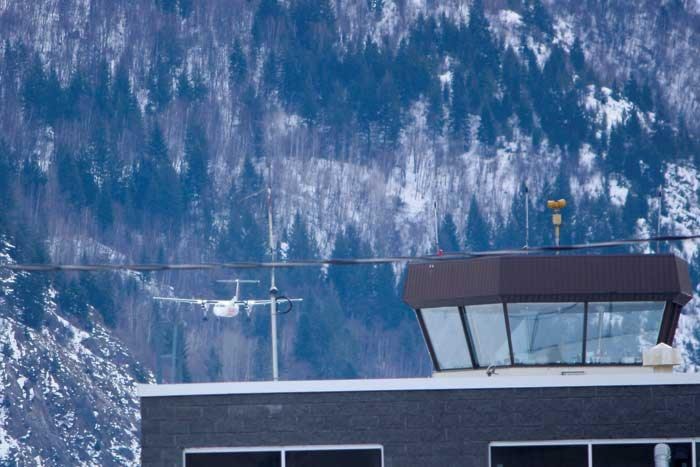Forty-one flights set to fly in and out of the West Kootenay Regional Airport were cancelled in December — more than one third of all flights scheduled for the month.
Castlegar Mayor Lawrence Chernoff said serious improvements to the city-owned airport will be considered this year, including studying landing systems at other airports with similar features to see how they deal with weather and terrain problems.
"It's an ongoing process,” he said. “Definitely when we look at the 40 cancellations, that's huge to us.”
He said the main issue is trying to find the right system that fits the small airport so more aircrafts can land, and also one that fits Canadian regulations.
The airport is often the subject of jokes, frequently being referred to as “Cancelgar” because of the high number of flight cancellations, but airport manager Gerry Rempel said 41 in one month is quite substantial.
“It’s the highest in quite a while,” he said. “It was terrible weather in December.”
In December 2009, 24 flights were cancelled and the December before that saw 34 cancellations.
The airport had 114 flights scheduled for December 2010, Rempel said.
The Northwest Regional Airport in Terrace used to see similar numbers of cancellations as the West Kootenay Regional Airport prior to installing an instrument landing system, or ILS. But airport manager Carman Hendry told the Terrace Standard last week only four flights were cancelled in December due to weather, thanks largely to the guidance provided by the ILS.
An ILS can cost well over $1 million, however, and is often too costly for smaller airports. Chernoff said Castlegar's airport simply hasn't found the right system yet.
He also noted that flight cancellations don’t just slow people down, they also slow down the area’s growth.
"What this really plays into is the economic development in the area,” Chernoff said. “We want people that want to come in to have the ability to do so. You don’t want to make it a three-day excursion.”
Pam McLeod, executive director at the Castlegar & District Chamber of Commerce, couldn’t agree more.
“Yes, it affects daily activities, it affects economic development and investor inquiries of people that want to get into the area and check us out,” she said.
“People should be able to jump on a plane in the morning and get into Castlegar, do their business and get back home on that 3 o'clock flight.”
“We're looking for the reliability of the airport because people get in and then they want to leave,” Chernoff added. “A day lost in business is costly.”
McLeod said from 1975 to 1980, the now-defunct airline Pacific Western landed Boeing 737 planes at the West Kootenay Regional Airport in bad weather — planes that seat more than double the amount of passengers that current Air Canada Jazz planes seat.
“Air Canada Jazz is dictating to us,” she said. “And we have the same navigational equipment as Pacific Coastal in Trail and their cancellations don't compare to ours.”
Ron Singer, a spokesman for Nav Canada, said the airline and the pilot have the final word on whether or not a flight will be cancelled.
“Nav Canada does not cancel flights,” he said. “It's always a decision by the airline. What we would do if in very bad weather conditions, we would have to slow or temporarily suspend landings.”
Singer also said airport landings are all about accessibility. Visibility issues, such as how low the cloud ceiling is, play a large role, as does the condition of the runway.
“If the runway needs to be plowed, we're not going to allow an airplane to land.”
He said a lack of air traffic control at Castlegar’s airport often factors in as well, leaving pilots to decide whether they can land or not once they’re in the airport’s vicinity.
“If the visibility at the airport falls below a half statute mile (2,600 feet), take-offs, landings, and ground movements are restricted [at the West Kootenay Regional Airport,]” Sara Hof, a communications officer with Transport Canada said. “For approaches at these levels, the airport needs special equipment and visual aids requirements which are regulated by the Canadian Aviation Regulations.”
Currently, Castlegar's airport doesn't have this equipment.
“Airports may decide whether or not to install equipment to permit take-offs at visibility below the standard,” Hof added. “If the airport chooses not to install the equipment, then operations at lower-than-normal visibility are not possible at that airport.”
The majority of December cancellations have been due to inclement weather in the area,” Debra Williams, manager or corporate communications and industry affairs for Air Canada Jazz said.
“Safety is our top priority at Jazz and we will only operate when and where it is safe to do so. Our operations personnel constantly monitor the weather across North America for our 800 daily flight operation.”
“Those decisions [to land or not] are coming from Halifax,” McLeod said, adding that she doesn’t think it’s fair for decisions to be made so early in the day from the other side of the country about flights in the West Kootenay.
“[Sometimes] their weather reports are saying we're socked in when all of a sudden we have blue skies,” McLeod said. “Why do we continue to go with Air Canada Jazz? Perhaps we should be looking into other airlines.”
Chernoff said better communication may be the key.
“We really want to take Nav Can and Air Canada Jazz into the formula and see how we can work together and see what the solution here is,” he said. “We need to sit down and talk to the airline and find out why flights are cancelled. It's a partnership we need to form.”
Along with working on the cancellation problem, Chernoff said he’s hoping the airport will be able to schedule night departures, even if it's for Medevacs only, starting this year.
